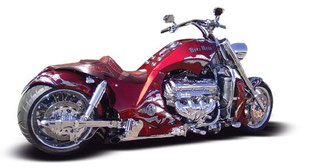BOSS HOSS Motorcycle PDF Manuals
Features of Boss Hoss Motorcycles
Above on the page there are several PDF Manuals for BOSS HOSS Motorcycles, Trikes.
To date, Boss Hoss has a reputation for producing perhaps the most American bikes, except perhaps for Harley-Davidson.
But Boss Hoss began much more modestly: not even selling motorcycles themselves, but kits for their construction - the so-called kit bikes.
In other words, the buyer got the frame, single-speed gearbox and many other very useful parts, but the engine and a few other minor details had to be obtained somewhere else.
The end result thus depended largely on the directness of the buyer's hands.
For these reasons, early Boss Hoss's often had a very homemade appearance, and sometimes even before the first trip they were overgrown with a set of parts intended for Harley-Davidsons and Chevy.
However, fans of rat bikes and other very raw looking cars existed at that time.
In addition, the well-built Boss Hoss was, although not the most comfortable, but still a full-fledged motorcycle.
Those few who used it on a daily basis could appreciate the difference in vibration between two cylinders and eight, and bikers who had at their disposal not only Boss Hoss, but also Harley Davidson, often preferred Boss Hoss at least in winter: the huge engine warmed their legs perfectly .
In short, despite all the shortcomings, the number of customers grew steadily, and so in '96, Monty Warne made enough money to move from kit bikes to building full-fledged motorcycles.
This approach allowed us to establish a full-fledged quality control, which quickly grew into an improvement in design and construction.
The V6 bikes Warne built in '97 and '98 were mostly experimental for the Boss Hoss brand.
In particular, it was the six-cylinder models that were first equipped with a new two-speed automatic transmission.
Plus, especially for a small engine from Chevrolet with a volume of 4.3 liters, the frame was narrowed and shortened.
But, despite this, the bike remained quite huge compared to other motorcycles.


